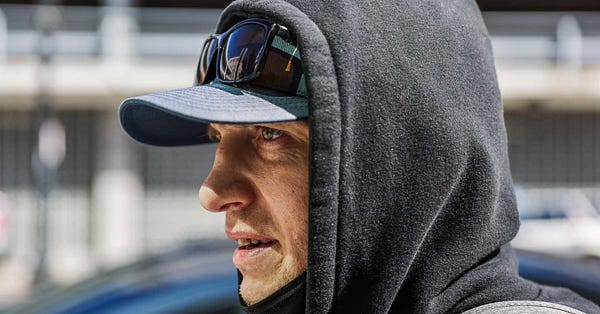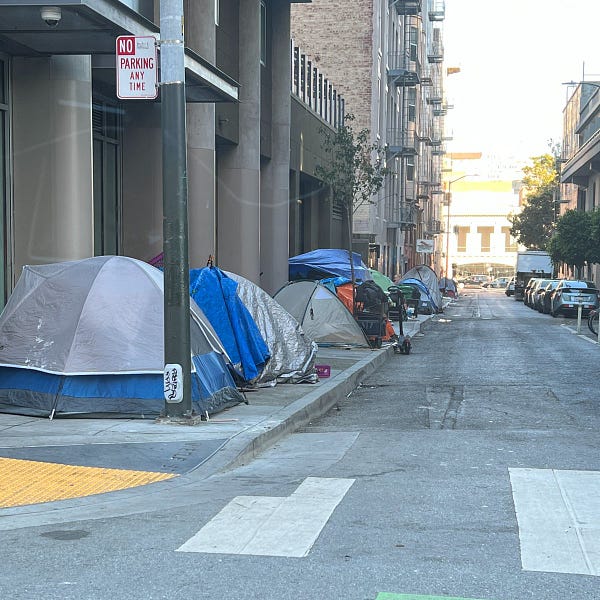How Cities Like San Francisco Enable Drug Addicts
The “Harm Reduction” disaster.
In America, when it comes to a wide variety of self-defeating behavior that leads to bad outcomes, we tend to take one of two different approaches to deal with it. Either…
1) We focus on strongly discouraging people from engaging in problematic behavior.
2) We focus on trying to help people engaged in problematic behavior and reduce the harm it causes in their lives.
Debates about issues like homelessness, single mothers, trans issues, and divorce all tend to revolve, at least in part, around these two approaches to the problem. Both approaches have different strengths and weaknesses.
The first approach is usually much cheaper and tends to dramatically reduce the scope of the problem at the price of being indifferent at best or perhaps even slightly cruel to the people suffering it at worst. Philosophically, Ben Franklin’s approach to poverty falls into this camp:
The second approach is usually very expensive and does much more to alleviate the suffering of the people afflicted with the problem, although it often does little to reduce the number of people with the problem. In fact, these sorts of policies can end up enabling the problem and leading to significantly larger numbers of people having the problem than we would have seen had NOTHING been done.
If you want to see an example of the second approach in action, read this thread by Michelle Tandler discussing the broken way that San Francisco “helps” drug addicts:
















First of all, if you’re a junkie, San Francisco is a paradise. It’s a rich city with a comfortable climate year-round. The government and liberal do-gooders will provide you with food, shelter, and needles. Drug use is essentially legal, the police are going to turn a blind eye and because there are so many junkies around, the drugs are cheap and easy to acquire.
The article Michelle Tandler mentioned early on goes into quite a bit of detail about the case of Ben Campofreda. Here are some excerpts that give you an idea of what this approach looks like in practice. Suffice it to say, it’s not pretty:
He funded his addiction by dumpster-diving, explaining to me that many San Franciscans are so rich that they throw away clothes with tags on them, sunglasses, electronics, and toys. He sold whatever items he could salvage by spreading them on a tarp or a blanket at Sixth and Market streets at night.
He often ate breakfast, used the bathroom, and got toiletries at Glide Memorial Church or St. Anthony’s, and got more goods from outreach workers.
“There was a lot of food offered,” he said. “People would hand out tents and sleeping bags, toothbrushes, deodorant, harm-reduction supplies. They would give out meth pipes, crack pipes, aluminum foil.”
The drugs were the easiest to score of all — dealers were everywhere, and fentanyl was dirt cheap — and soon his life was entirely centered around scoring his next hit.
“The dealers figured out the science of that one real good,” he said of fentanyl. “It’s a jackpot for them. You constantly need it, you constantly want it and you’ll do anything you can to get it.”
A cop, every so often, would approach him in the Tenderloin and tell him to put his drugs away. He doesn’t recall a single outreach worker offering him treatment on the street, even as the city’s drug crisis grew so severe that one or two people, on average, died of overdoses every day.
He rarely slept at night, using methamphetamines to stay awake, and sometimes stretched out on a pew at St. Boniface Church to doze during the day.
“Everywhere else,” he said, “you’ll just get robbed.”
He managed to get by OK for a while, but then an infection in his legs made its way into his spine, and he couldn’t walk. He became confined to a wheelchair, unable to use the bathroom or get food without help. He normally weighed 170 pounds, but as his health grew worse, he shrunk to a startling 100 pounds. His hands grew red and puffy, a common symptom of opioid use.
...One thousand two hundred and seventy-four. By the count of Judi Johnson, that’s the number of days her son was homeless.
“San Francisco reminds me of a Mad Max movie,” she said. “It’s beautiful and the weather’s nice, but I don’t understand how you can let people do drugs on the street like that. It’s not compassion. It didn’t seem like there was any help.”
That last sentence from Judi Johnson really hammers home the point because clearly, her son was getting ALL KINDS OF HELP. Unfortunately, it was just the kind of help that makes you think about that famous quote from Ronald Reagan:
At what point does “help” turn into “enabling?” How far do you have to go to protect someone from the consequences of their own mistakes until you realize that you’re becoming part of the reason they’re making the mistake?
Usually, we look at situations like the one we see in San Francisco and think about them from the perspective of innocent victims. How would you feel if you had to step over needles in the streets, junkies broke into your car five times this year and you didn’t feel safe letting your wife walk to the grocery store alone past groups of bedraggled men, shooting up on the street corners? It sounds awful right? No citizen who pays their taxes should be repaid by having to deal with that horror show.
However, think about it from the perspective of the junkies. Is what’s going on in San Francisco really benefitting THEM? The reflexive answer from the activists is, “YES! They have food! They have a place to stay! We’re keeping them alive until they choose to get clean!” Ok, but how many of them would have already said, “Geeze, this lifestyle sucks! I have to get off this crap” if San Francisco hadn’t made it so much more tolerable for them? How many of them would have been forced to get clean the hard way if the police were allowed to throw them in jail for using? How many of them only ended up becoming addicts in the first place because of San Francisco’s policies? San Francisco says, “Here’s food, here’s needles, here’s a place a stay, here’s easy, cheap access to drugs.” Then, what? Are we supposed to be surprised they’re overrun with junkies? No. The government and activists in San Francisco have undoubtedly been responsible for huge numbers of people becoming addicted and dying by giving them “help.” Some “help” that is.
Of course, it infuriates people who falsely call these kinds of policies “compassion” to point out what they really do. “Oh, you think someone is going to give up on getting a job for the little amount of money that welfare pays? Do you think someone is more likely to be HOMELESS because they can get into shelters and get fed a crummy meal per day? Do you think someone is more likely to get hooked on a drug like fentanyl in somewhere like San Francisco than in a place where it’s highly discouraged?”
Look at the results of these policies. Obviously, the answer to all those questions is, “Yes.”
You create an environment where it’s as easy as possible to be an addict and guess what? You will CREATE a lot more addicts than you otherwise would. Not only are these policies bad for the law-abiding citizens of San Francisco, ultimately the price of coddling the addicts that are there now is more addicts. That’s not a kindness, it’s something the city of San Francisco should be ashamed of allowing to happen.




This is crazy. We all see how the Left tries to claim the moral high ground by claiming that they care and are trying to help, yet how often do we see the Left acknowledge the truth in stories like this one about the results of that "help?" They generally just drive by, but if forced to answer, will say something stupid like; "we just need more funding/more resources to expand the program." That's why I always find myself coming to a very negative conclusion about people on the Left. Are they really that stupid, that they can't see how they made the problem worse, or are they just so self-absorbed and narcissistic that they only care about how virtuous they felt for "caring and trying to help," and nothing really for the new victims they've created? Disgraceful; no wonder San Fran is so often called the "new Sodom and Gomorrah."